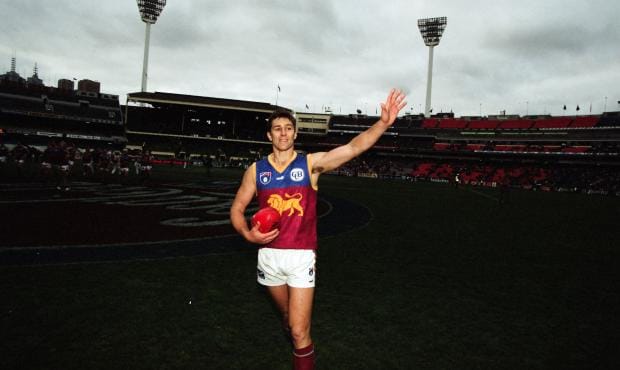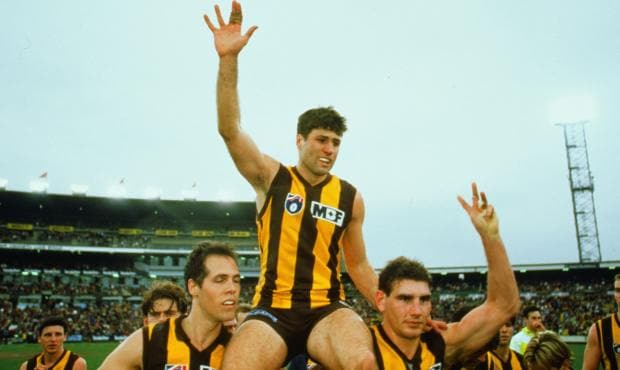Chris Pelchen has been to every national draft since the first in 1986, working first for the then VFL, followed by Hawthorn (twice), Port Adelaide and St Kilda. He will be writing about the forthcoming draft and list management issues for the next three weeks on AFL.com.au.
NOVEMBER 26, 1986 was a watershed day in the history of VFL/AFL football. On that day, in the main function room on the third floor of the old VFL House on Jolimont Road (around the corner from the MCG), the first national draft took place.
Thirteen of the 14 clubs took turns to make their selections, with West Coast the exception. The Eagles had already formed their inaugural list from local players and current VFL players returning to Western Australia.
There were a few faces at that inaugural draft that will be there later this month in the 2014 edition on the Gold Coast, including Kevin Sheehan, Shane O'Sullivan, John Beveridge and Stephen Wells. The VFL's football staff of the time were the late Alan Schwab (the principal architect of the draft system), Don Hanly, Dean Moore, Mark Patterson, Wayne Holdsworth and myself.
I was a young administrator with the VFL in 1986 and had the "huge" responsibility of writing the players' names on the whiteboard at the front of the room as each club called them out. But to give an indication of how little thought was given to the draft back then, several of the surnames on the board were either inaccurate or misspelled by the clubs nominating them. In some instances, they had barely more of a clue about the players than I did.
The draft system was established in 1986 following almost two years of research by the VFL into various recruiting systems from around the world – principally the NFL, NBA and NHL in the United States, soccer in the United Kingdom and other "boutique" competitions such as basketball and soccer throughout Europe. And the first national draft was restricted to players from country Victoria or outside the state, because local metropolitan zoning was retained in the AFL competition until 1991.
But it was a measure of how haphazard the recruiting process had been until then that not all VFL clubs employed a full-time recruiting officer in 1986. Noel Judkins (Essendon), Bill McMaster (Geelong) and John Beveridge (St Kilda) were some of the known recruiters at the time, but for most other clubs, recruiting activities were spread among various members of their football department.
Whereas the recruiting budget at AFL clubs these days would be between $1 million and $2 million each year, back in 1986, clubs would have been lucky to allocate $100,000 on finding new players. They didn't really need to spend any more than that; player lists until then had been formulated primarily through metropolitan and country zoning combined with the previous 'Form 4' signing of interstate players on a first-in, first-served basis.
In the 1970s and '80s, footy was dominated by four clubs. I remember Alan Schwab regularly suggesting that clubs such as Carlton, Collingwood, Essendon and Hawthorn would continue to share the premiership between them unless new systems of recruiting and player payments were introduced:
"Bloody 'Sheeds' or 'Yabby' (Hawthorn coach Allan Jeans) will win the flag every year if we don’t get something sorted soon," was a line he often trumpeted through the VFL office.
'Schwabby' was a passionate Richmond man and he especially couldn't stand the thought of the Blues and Magpies winning premierships at the expense of his beloved Tigers for the next 50 years!
So the draft was introduced in 1986 along with a more stringent 'salary cap' (TPP) and they became the critical platforms of the national competition. And they remain so today. I remember some of the running battles that Don Hanly and the late Jill Lindsay had with clubs as they initially resisted these measures and vowed to circumvent them at every opportunity.
But in any event, drafting in the early days was an inexact science. As an example, Hawthorn had five selections in the inaugural draft of 1986 and while the eventual career tally of 215 AFL games from that draft would eventually represent one of the better outcomes, 211 of those games came from just one player – Darrin Pritchard, the champion wingman from Sandy Bay in Tasmania.
Darrin Pritchard was one of the best players to come from the inaugural draft. Picture: AFL Media
Back in 1986, many players nominated in the draft were not even interviewed prior to their selection or maybe only spoken to by phone. Compare that with now, when AFL clubs will personally interview approximately 80 to 100 players throughout Australia each year – most in their own homes. Having four or five full-time recruiters and up to 20 part-time staff around the country will allow each club to do that effectively.
One past experience that illustrates how decisions used to be made on a whim occurred while I was employed at Hawthorn in 1990. While the Hawks were appropriately prepared for the national draft that year, on the morning of the draft a facsimile arrived in the office at Glenferrie Oval as we were literally about to depart for the actual event, which advised that South Fremantle's Willie Rioli (Cyril's uncle) was eligible for the draft despite some conjecture surrounding his availability. While our recruiting staff had not actively followed Willie and no formal interview had been conducted with him, one of the Hawks' coaches felt he was just the type of player the club needed so we were subsequently instructed to select him with pick No.48 that same day – without any of the due diligence that is much the norm of 2014.
Such a move would be unthinkable now. Clubs will watch a player on numerous occasions before deciding to recruit them – most players in the elite talent pathways around Australia are watched on a weekly basis. Combine that with interviews, video analysis and statistics from organizations such as Champion Data, the profiling of players is far more detailed than history allowed.
There was no use of social media to undertake character references on players in the 1980s. Instead, talking to their local coach or the shopkeeper at the general store in their hometown did that. These days it is commonplace to have clubs scouring Facebook, Twitter or Instagram for hours to conduct thorough background checks on each player – their capacity and suitability to represent a club's brand plays almost as important part as their football ability in any decision to recruit them.
Taken with pick No.50 in the inaugural draft, Alastair Lynch played in three flags. Picture: AFL Media

But all the technology in the world can't help in the case of bad luck. I remember travelling to Alice Springs for Hawthorn in 1991 to watch a player in a game between Souths and Pioneers. The limited flights at the time meant that the one direct flight from Melbourne to Alice Springs arrived on a Friday evening while the return flight would need to be on Sunday afternoon because the Saturday flight arrived and departed too late for the start of the game. As it turned out, the player I went to see was involved in a massive brawl in the opening minutes of the match which involved all players and as well as numerous spectators. The player in question was taken away by local police in the back of a divvy van for allegedly hitting a spectator, so not only did he not play for the remainder of that match, he didn't play again for many weeks after. Suffice to say, we didn't draft him to Hawthorn that year!
Over the journey, twice with the Hawks and also with Port Adelaide and St Kilda, I have traversed all parts of the country. In the 1980s, it was quite normal to drive more than 25,000kms per year watching football games and the success of country trips was often rated by which club had the warmest change rooms or local bakery with the best meat pie – especially when the performance of the players didn’t quite live up to expectations.
And it was also common before the TAC Cup (and the Internet) to drive to distant towns like Mildura, Myrtleford or Mallacoota only to discover on arrival that the player you had gone to see had either just withdrawn from the team or was unfortunately injured in the opening minutes of the game. On those days, the drive home felt even longer than the drive there.
Thankfully, the game has changed. The draft is now an intricate but complex recruiting program comprising thousands of hours of research and planning, which leads to more informed decisions by AFL clubs than ever before.
Draft day on November 27 2014 will be a day not left to chance nor a whim!




